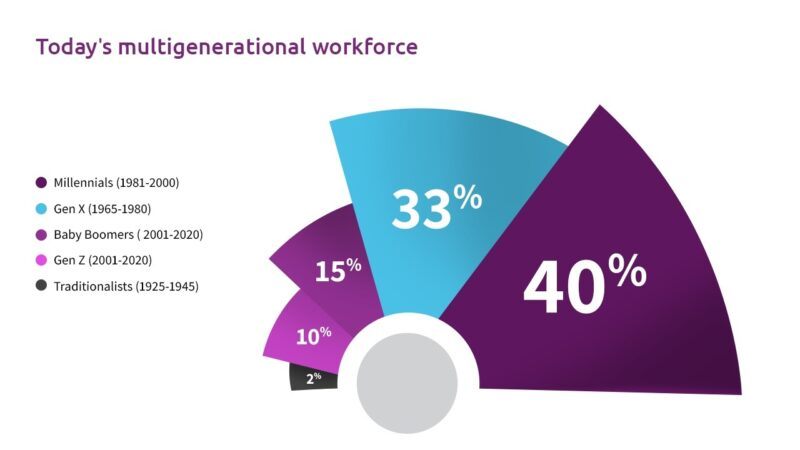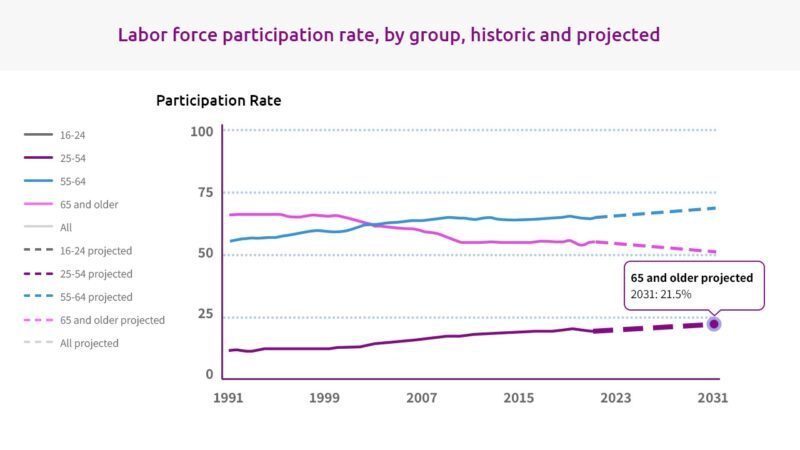Engaging A Multigenerational Workforce
There's a paradigm shift in workforce compositions today. And it's impacting everything—from how individuals choose to interact (in person vs. virtually) and work (on premises vs. remotely), to communication preferences (one-on-one, in-person, text, voice, video), and rewards and benefits. And yes, this paradigm change also impacts how employees learn and develop.
According to data, millennials (born 1981–2000) represent the highest concentration in today's workforce at 40%, closely followed by Gen X (1965–1980) at 33%. With a significant proportion of boomers (1946–1964) already retired or heading there, that generation now represents just 15% of today's workforce, while Gen Z (2001–2020) comes in at 10%.

Data sources: [1], [2]
Advancements in healthcare and longevity mean that people now have the potential to live longer lives. The recent economic malaise has put pressure on intending retiree finances. Consequently, workers are reconsidering retirement plans and extending careers beyond the traditional retirement age. With individuals working for six or more decades, the U.S. Bureau of Labor Statistics predicts that more than 68% of workers will be aged 55–64 by 2031, with 20% projected to be 65 years or older.

This demographic shift has led to the emergence of a multigenerational workforce. Moving forward, organizations must adapt to this reality by implementing age-friendly practices, fostering learning and engagement across generations, and creating inclusive workplace cultures. For this multigenerational workforce to be effective and productive, individuals must continue to learn and grow while employed. Achieving this requires companies employing multigen workforces to put effective learning strategies in place.
Generational Learning
Understanding the realities of generational learning is essential for Learning and Development (L&D) leaders. This enables leaders to tailor learning approaches, improve communication, and increase engagement. Recognizing diverse preferences contributes to productivity, skill development, and effective retention strategies. Additionally, it supports succession planning and facilitates the integration of technology. Ultimately, this understanding fosters an inclusive organizational culture, benefiting both individual employees and the broader organization.
Benefits Of Generational Learning
In today's dynamic work environment, the convergence of different generations brings forth a rich tapestry of experiences, perspectives, and skills. From baby boomers to Gen Z, each cohort contributes unique value to the workforce. Here are some of the benefits of fostering a multigenerational team.
Holistic Perspectives
Imagine a mosaic where each tile represents a distinct viewpoint. A multigenerational workforce mirrors this diversity. By blending insights from seasoned professionals and fresh graduates, organizations gain a 360-degree perspective on challenges and opportunities. This kaleidoscope of viewpoints fuels innovation and drives better decision making.
Creative Problem Solving
Picture a brainstorming session where a seasoned executive and a tech-savvy intern collaborate. The combined wisdom and digital fluency yield ingenious solutions. Age-diverse teams excel at problem solving and experimentation, fusing traditional wisdom with cutting-edge approaches. The result? Creative breakthroughs that propel businesses forward.
Cross-Generational Mentorship
The mentorship process need not follow a linear path. Seasoned leaders impart battle-tested knowledge, while young talents infuse fresh energy. But here's another benefit: reverse mentoring. Junior employees, armed with digital prowess, guide tenured colleagues through the ever-evolving tech landscape. It's a symbiotic exchange that enriches both parties.
Knowledge Continuity
Tacit knowledge, accumulated over decades, resides within the hearts and minds of experienced employees. When shared across generations, it becomes an organizational treasure trove. The company's legacy remains intact as baby boomers pass the torch to millennials and Gen Z. In-house promotion has become the norm, reducing reliance on external hires.
Workplace Bonds
A diverse workplace steeped in generational knowledge provides an environment of continuous learning when leveraged correctly. In a multigenerational setting, unique relationships blossom. Whether it's a Gen Xer mentoring a Gen Yer or a Gen Zer teaching a boomer about digital trends, these connections foster job satisfaction and emotional well-being.
A multigenerational workforce isn't just about bridging age gaps; it's about creating a vibrant workforce where wisdom, innovation, and camaraderie intersect. Organizations thrive with learning strategies that empower age diversity.
Challenges
In today's corporate world, the intersection of diverse generational cohorts also brings forward an array of challenges.
Evolving Communication Dynamics
Consider situations where a seasoned executive values face-to-face conversation, while tech-savvy interns excel in quick text and online chat exchanges. Bridging these communication gaps requires adaptability. The solution lies in adopting flexible communication channels—whether it's email, video calls, or casual hallway discussions—tailored to fit each generation's unique communication style.
Dispelling Stereotypes
In workplaces with a diverse age range, ingrained patterns and stereotypes may emerge. Baby boomers might view Gen Z as overly sensitive and inexperienced, while the younger generation may see boomers as resistant to technology. Left unaddressed, these stereotypes can create a negative atmosphere. The goal is to dismantle biases, fostering an inclusive environment where the combination of wisdom and innovation prevails.
Shifting Expectations
Imagine a performance review where a Gen X manager evaluates a millennial's contributions. Criteria differ—experience versus agility, stability versus adaptability. Compensation and benefits become varied: stock options for one, remote work for another. Navigating these diverse expectations requires a personalized approach, like using a custom compass to navigate unfamiliar territory.
Addressing the challenges in a multigenerational workforce isn't complicated. To make multigenerational organizations grow and thrive, it's important to embrace diversity and harmonize various perspectives across cohorts of various age groups of employees.
Effective Learning Strategies
L&D leaders may consider leveraging the following strategies to create highly effective learning strategies in multigenerational workplaces:
- Understand the audience – Creating tailored learning inclusive of the recognition of diverse learner needs, preferences, and personalized learning approaches is key in promoting successful engagement.
- Design for inclusivity – Develop learning that embraces diversity, ensuring accessibility and relevance for all members of the multigenerational workforce.
- Types of learning – Offer a variety of learning formats, such as online courses, workshops, mentorship programs, and collaborative projects, to accommodate diverse learning preferences.
- Enhance communication with learners – Establish clear and open communication channels to keep learners informed and engaged throughout the learning process.
- Bridge the gap – Facilitate collaboration sessions that encourage interaction and knowledge sharing among employees from different generations.
- Promote – Encourage feedback from employees at all levels, including managers and leaders, to continually improve learning programs and adapt to evolving needs.
- Create a culture of continuous learning – Learning strategies must instill a mindset of ongoing learning and professional development as a fundamental aspect of the organizational culture.
Remember, a multigenerational workforce thrives when learning becomes a shared journey—a bridge connecting past wisdom and future innovation.
Personalize Learning For All Workforce Generations
While it may seem like an extensive list of demands and anticipations to address, implementing simple adjustments in learning strategies can effectively customize the approach for individuals of all age brackets.
- Let the learner take the lead – Empower individuals to define career goals, interests, and learning preferences. Enable learners to take charge of their learning journey.
- Explain the benefits of learning – Busy employees need a compelling reason to invest time in learning. Clarify the purpose behind learning initiatives. Design with the learner at the center of the learning experience providing a holistic approach to value and participation.
- Mentoring and reverse mentoring – Bridging generational gaps fosters collaboration and mutual learning. Implement mentoring and coaching programs, including reverse mentoring—where younger employees teach digital skills to tenured employees. This creates a symbiotic exchange, ensuring knowledge transfer.
- Learning through real business scenarios – Theoretical learning gains depth when applied in real-world scenarios. It's like learning to swim by (actually) diving into the pool. Encourage learners to manage actual projects, handle stretch assignments, or participate in temporary redeployments. These experiences solidify skills and prevent forgetting.
Conclusion
Fostering a multigenerational workplace necessitates breeding a culture of inclusivity and knowledge exchange, ultimately boosting innovation and problem-solving prowess. By investing in inclusive learning initiatives, organizations equip employees across diverse generations with the essential skills needed for prosperity. This strategic approach unlocks the full potential of a multigenerational workforce, leading to business optimization and heightened collective effectiveness.
References:
[1] What The Generations Want From Work: New Data Offers Surprises
[2] Business Statistics 101: The Virtues of a Multigenerational Workforce
Read More:
- Research Brief: The Importance of Emotional Intelligence in the Age of AI [eBook]
- AI in Training – How Artificial Intelligence is Transforming the Learning Technology Landscape
- How to Design and Develop Engaging Learning Programs Using Learning Technology
- Modernizing L&D – Technology Trends to Help Design, Develop, and Deliver Impactful Learning Programs
- AI in eLearning – How Natural Language Processing and Other AI-enabled Solutions Will Transform the Industry


